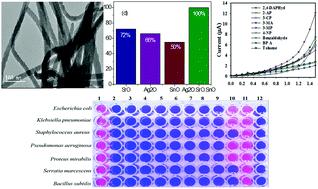当前位置:
X-MOL 学术
›
New J. Chem.
›
论文详情
Our official English website, www.x-mol.net, welcomes your
feedback! (Note: you will need to create a separate account there.)
Photocatalytic, anti-bacterial performance and development of 2,4-diaminophenylhydrazine chemical sensor probe based on ternary doped Ag·SrSnO3 nanorods
New Journal of Chemistry ( IF 2.7 ) Pub Date : 2020-12-18 , DOI: 10.1039/d0nj04813e Md Abdus Subhan 1, 2, 3, 4, 5 , Tanjila Parvin Rifat 1, 2, 3, 4, 5 , Pallab Chandra Saha 1, 2, 3, 4, 5 , M. M. Alam 3, 5, 6, 7 , Abdullah M. Asiri 8, 9, 10, 11, 12 , Topu Raihan 3, 4, 5, 13 , Abul Kalam Azad 3, 4, 5, 13 , William Ghann 14, 15, 16, 17, 18 , Jamal Uddin 14, 15, 16, 17, 18 , Mohammed M. Rahman 8, 9, 10, 11, 12
New Journal of Chemistry ( IF 2.7 ) Pub Date : 2020-12-18 , DOI: 10.1039/d0nj04813e Md Abdus Subhan 1, 2, 3, 4, 5 , Tanjila Parvin Rifat 1, 2, 3, 4, 5 , Pallab Chandra Saha 1, 2, 3, 4, 5 , M. M. Alam 3, 5, 6, 7 , Abdullah M. Asiri 8, 9, 10, 11, 12 , Topu Raihan 3, 4, 5, 13 , Abul Kalam Azad 3, 4, 5, 13 , William Ghann 14, 15, 16, 17, 18 , Jamal Uddin 14, 15, 16, 17, 18 , Mohammed M. Rahman 8, 9, 10, 11, 12
Affiliation

|
In this approach, Ag·SrSnO3 nanocomposites were synthesized by a co-precipitation method and characterized by IR, XRD, SEM, EDS, CV, EIS, and TEM measurements. The nanocomposite Ag·SrSnO3 was crystallized in nanorods (NRs) with Ag on the surface, as revealed by SEM and TEM studies. Ag·SrSnO3 shows excellent photocatalysis for dye degradation and anti-bacterial activity against both Gram positive and Gram negative pathogenic bacteria. Here, to develop a selective 2,4-diaminophenylhydrazine (2,4-DAPHyd) electrochemical sensor, a thin layer of prepared Ag·SrSnO3 NRs was deposited onto a glassy carbon electrode (GCE) with Nafion as the conductive binder (5% Nafion) in ethanol. The slope obtained from the curve of a plot of current versus concentration of 2,4-DAPHyd, denoted the calibration curve, was used to calculate the sensitivity (7.5854 μA μM−1 cm−2) of the Ag·SrSnO3 NRs sensor. The linear dynamic range (LDR) of detection is 0.1 nM–0.01 mM. The lowest limit of detection (LOD; 96.13 ± 4.81 pM) of the Ag·SrSnO3 NR sensor was calculated at S/N = 3 (signal to noise ratio). Furthermore, the Ag·SrSnO3 NR sensor shows good reproducibility, long duration for performing sensing ability and a short response time and validation in real samples, which were collected and extracted from various sources.
中文翻译:

三元掺杂Ag·SrSnO3纳米棒的2,4-二氨基苯肼化学传感器探针的光催化,抗菌性能及开发
该方法通过共沉淀法合成了Ag·SrSnO 3纳米复合材料,并通过红外,X射线衍射,扫描电镜,电子能谱,电子伏安,EIS和TEM测量表征。SEM和TEM研究表明,纳米复合材料Ag·SrSnO 3在表面带有Ag的纳米棒(NRs)中结晶。Ag·SrSnO 3对染料的降解和对革兰氏阳性和革兰氏阴性致病菌均表现出优异的光催化作用。在这里,为了开发选择性的2,4-二氨基苯肼(2,4-DAPHyd)电化学传感器,将制备的Ag·SrSnO 3 NRs薄层沉积在玻璃纤维电极(GCE)上,以Nafion作为导电粘合剂(5% Nafion)在乙醇中。从电流图的曲线获得的斜率相对于2,4-DAPHyd的浓度(表示校准曲线),用于计算Ag·SrSnO 3 NRs传感器的灵敏度(7.5854μAμM -1 cm -2)。检测的线性动态范围(LDR)为0.1 nM–0.01 mM。Ag·SrSnO 3 NR传感器的最低检测限(LOD; 96.13±4.81 pM)是在S / N = 3(信噪比)时计算得出的。此外,Ag·SrSnO 3 NR传感器具有良好的重现性,执行感测能力的持续时间长,响应时间短以及在真实样品中的验证,这些样品是从各种来源收集和提取的。
更新日期:2021-01-11
中文翻译:

三元掺杂Ag·SrSnO3纳米棒的2,4-二氨基苯肼化学传感器探针的光催化,抗菌性能及开发
该方法通过共沉淀法合成了Ag·SrSnO 3纳米复合材料,并通过红外,X射线衍射,扫描电镜,电子能谱,电子伏安,EIS和TEM测量表征。SEM和TEM研究表明,纳米复合材料Ag·SrSnO 3在表面带有Ag的纳米棒(NRs)中结晶。Ag·SrSnO 3对染料的降解和对革兰氏阳性和革兰氏阴性致病菌均表现出优异的光催化作用。在这里,为了开发选择性的2,4-二氨基苯肼(2,4-DAPHyd)电化学传感器,将制备的Ag·SrSnO 3 NRs薄层沉积在玻璃纤维电极(GCE)上,以Nafion作为导电粘合剂(5% Nafion)在乙醇中。从电流图的曲线获得的斜率相对于2,4-DAPHyd的浓度(表示校准曲线),用于计算Ag·SrSnO 3 NRs传感器的灵敏度(7.5854μAμM -1 cm -2)。检测的线性动态范围(LDR)为0.1 nM–0.01 mM。Ag·SrSnO 3 NR传感器的最低检测限(LOD; 96.13±4.81 pM)是在S / N = 3(信噪比)时计算得出的。此外,Ag·SrSnO 3 NR传感器具有良好的重现性,执行感测能力的持续时间长,响应时间短以及在真实样品中的验证,这些样品是从各种来源收集和提取的。









































 京公网安备 11010802027423号
京公网安备 11010802027423号